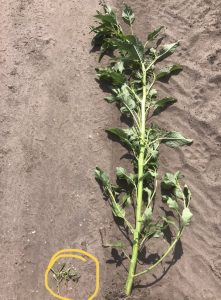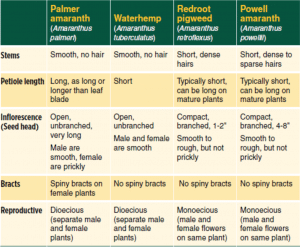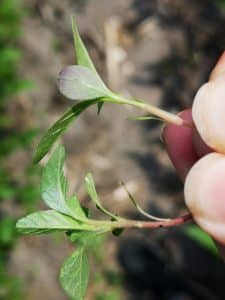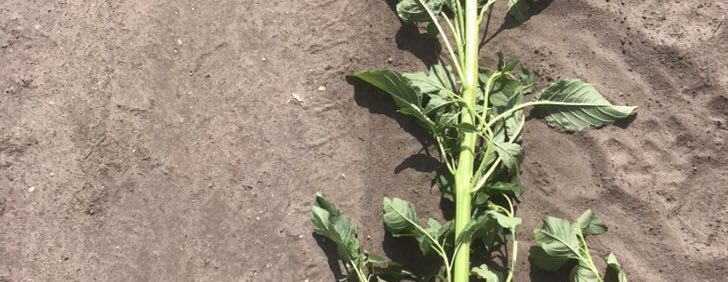Tall waterhemp is confirmed in eastern Manitoba. Palmer amaranth is in North Dakota and moving north toward Manitoba and Saskatchewan. Both are big aggressive weeds with populations resistant to many herbicides, including glyphosate. If you find them, destroy them immediately.
Tall waterhemp and palmer amaranth are both pigweeds; relatives of other more common pigweeds such as redroot pigweed, Powell amaranth (green pigweed), tumble pigweed and prostrate pigweed.


In the U.S., tall waterhemp populations with 7-way herbicide resistance are confirmed: Groups 2, 4, 5, 9, 14, 15 and 27. While herbicide resistance is not confirmed within the Manitoba population, resistance to Groups 2, 5 and 9 is suspected.
Tammy Jones, Manitoba Agriculture’s weed specialist, encourages farmers to learn to identify these two weeds and scout for them. She provides details in this webinar. The NDSU factsheet (the source for the table above) is also a very good resource.
Seedling ID. Cotyledons of tall waterhemp are pointed while redroot pigweed cotyledons are round. True leaves of waterhemp will be narrow (about four times longer than they are wide) while pigweed’s are broad and egg shaped (2-3x long as wide). Jones provides the following photo comparing redroot pigweed to tall waterhemp. At around the third or fourth leaf stages, Redroot pigweed will have hairs while tall waterhemp does not.

Tall waterhemp and palmer amaranth are ‘Tier 1 Noxious’ weeds in Manitoba. (They are not regulated in Alberta or Saskatchewan.) For Manitoba farmers who find a Tier 1 Noxious weed, the legal requirement is that all the plant parts including the seeds must be destroyed. In addition, any machinery (farm, construction, etc.) that is in an area where there is a noxious weed must be cleaned prior to being moved to prevent weeds spreading. Jones adds: “Scouting prior to harvest is important, not only to detect these noxious weeds and remove them as is legally required, but to help avoid weeds being combined and spreading them in the field and beyond.”
The onus is on the landowner and farmer to find and destroy weeds on the prohibited/noxious list for each province. This is in the best interest of the farm and the region. A municipality’s appointed weed inspector has the ability to destroy weeds and recoup the costs from the landowner, but as Saskatchewan weed specialist Clark Brenzil says, “The real key thing to note is no one is ever charged or fined for having one of these weeds on their property, only for being unwilling to do anything about it.”
Each province has its own Weed Act, which includes province-specific definitions, rules and weeds to watch for.
Alberta. The Weed Control Act lists ‘prohibited noxious’ and ‘noxious’ weeds. Tall waterhemp and palmer amaranth are not on either list in Alberta. Farmers, like all landowners in Alberta, have to comply with the Weed Control Act, and the act is enforced through the Agricultural Service Boards and municipalities.
Saskatchewan. The Weed Control Act in Saskatchewan has ‘prohibited’, ‘noxious’ and ‘nuisance’ weeds. Weeds on the ‘prohibited’ list require immediate eradication. Clark Brenzil says tall waterhemp and palmer amaranth are not regulated in Saskatchewan as of yet, but when the weed list is updated, they would likely be good candidates for proposed inclusion in the prohibited category. Neither of those two weeds is known to exist in Saskatchewan at this time.
The Weed Control Act (Saskatchewan) says the landowners’ duty is to notify any occupants, within five business days after their detection, of the presence of any prohibited, noxious or nuisance weeds. With prohibited or noxious weeds, the landowner must also notify the municipality or the weed inspector for the municipality within five business days after their detection. And every owner or occupant of land shall, under the supervision of the weed inspector, eradicate any prohibited weeds located on the land.
